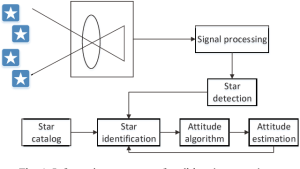Star tracker attitude determination is a critical technology in the field of space exploration, providing precise orientation information for spacecraft and satellites. By leveraging the positions of stars, star trackers enable accurate attitude determination, which is essential for navigation, communication, and scientific missions. This article explores the importance of star tracker attitude determination, how it works, and its applications in modern space missions.

The Importance of Star Tracker Attitude Determination
Star tracker attitude determination plays a pivotal role in ensuring that spacecraft maintain their intended orientation in space. This technology is vital for a wide range of applications, from stabilizing Earth observation satellites to ensuring the precise pointing of space telescopes. Accurate attitude determination is crucial for the success of these missions, as even minor deviations can lead to significant errors in data collection and communication.
How Star Tracker Attitude Determination Works
The process of star tracker attitude determination involves several key steps:
- Star Sighting: Star trackers capture images of the star field using high-resolution sensors. The captured images are then processed to identify individual stars.
- Pattern Matching: The identified stars are compared with a preloaded star catalog. This involves matching the observed star patterns with known constellations and star positions in the catalog.
- Orientation Calculation: Based on the matched star patterns, the star tracker calculates the spacecraft’s orientation. This involves determining the roll, pitch, and yaw angles, which define the spacecraft’s attitude relative to a known reference frame.
- Real-Time Updates: Star trackers continuously update the spacecraft’s orientation, providing real-time attitude information that is crucial for navigation and control.
Key Features of Star Trackers
Star trackers are equipped with several advanced features that enhance their performance in attitude determination:
- High-Resolution Sensors: Modern star trackers use advanced CCD and CMOS sensors that provide high-resolution images of the star field, allowing for the detection of faint stars and improving accuracy.
- Sophisticated Algorithms: The algorithms used in star trackers for star detection, pattern matching, and orientation calculation are highly sophisticated, enabling precise and reliable attitude determination.
- Robust Design: Star trackers are designed to withstand the harsh conditions of space, including radiation, temperature fluctuations, and mechanical stresses.
Applications of Star Tracker Attitude Determination
Star tracker attitude determination is employed in a variety of space missions, each requiring precise orientation control:
- Earth Observation: Earth observation satellites rely on accurate attitude determination to maintain the correct orientation for capturing high-resolution images and data.
- Space Telescopes: Space telescopes require precise pointing to observe distant celestial objects. Star trackers ensure the telescope remains correctly oriented during observations.
- Communication Satellites: Communication satellites need to maintain stable orientation to keep their antennas aligned with ground stations, ensuring uninterrupted signal transmission.
- Scientific Probes: Space probes exploring other planets or celestial bodies use star tracker attitude determination to maintain the correct orientation for instrument aiming and data collection.
Advantages of Star Tracker Attitude Determination
The use of star tracker attitude determination offers several significant advantages:
- High Precision: Star trackers provide extremely accurate attitude measurements, often within a few arcseconds, ensuring precise orientation control.
- Reliability: Modern star trackers are highly reliable, capable of operating autonomously and continuously providing accurate attitude information.
- Adaptability: Star trackers can adapt to various mission scenarios, making them suitable for a wide range of spacecraft and satellite applications.
Challenges and Future Developments
Despite the advancements in star tracker technology, several challenges remain:
- Space Debris and Light Pollution: Space debris and light pollution can interfere with star detection, requiring robust algorithms to filter out such noise.
- Thermal Variations: Temperature fluctuations in space can affect the performance of optical components and sensors. Effective thermal management solutions are needed to mitigate these effects.
Future developments in star tracker attitude determination aim to enhance their robustness and accuracy. Research is ongoing to develop more resilient materials, advanced thermal management systems, and AI-driven algorithms to improve the performance and reliability of star trackers.
In conclusion, star tracker attitude determination is a vital technology for modern space missions, providing the precise orientation control necessary for navigation, communication, and scientific exploration. With continuous advancements in sensor technology, algorithms, and design, star trackers will continue to play a crucial role in the success of space missions, ensuring accurate and reliable attitude determination for spacecraft and satellites.
![]()